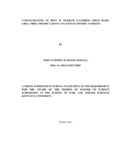Concentration of Iron in Murram (Laterite) From Ruiru Area, Thika District, Kenya To Asses Economic Viability.
Abstract
A study on possibility of concentrating iron in laterite (murram) has been carried out. This was done using froth floatation where oleic acid was used as collector and cresylic acid as frother. Magnetic separation was also used. The study has shown that the level of iron in the original sample could be increased from 33% to 55%. Mineral content was determined using X-Ray diffraction which identified iron mineral present as goethite. Chemical analysis was also carried out on raw and concentrated material using Atomic Absorption Spectroscopy (AAS), X-Ray Fluorescence Spectroscopy (XRFS) and titrimetric analysis using ethylenediamine tetra acetic acid (EDTA). Results have also shown that iron present in these laterite, goethite were converted to magnetite by mixing laterite with charcoal and then heating the mixture using charcoal as the source of energy. Magnetite so formed was then concentrated using magnetic separation. It has also been shown that froth flotation can be viably used to concentrate iron in laterite. This method is affordable because the chemicals used for flotation were recovered by washing the concentrate with 1:1 diethyl ether, filtered using vacuum filtration. Diethyl ether was allowed to evaporate and chemicals recovered recycled. Magnetic separation increased amount of iron by 17.98 percent and froth flotation by11.74 percent. The data was analysed using student‘s t- test and analysis of variance (ANOVA).

